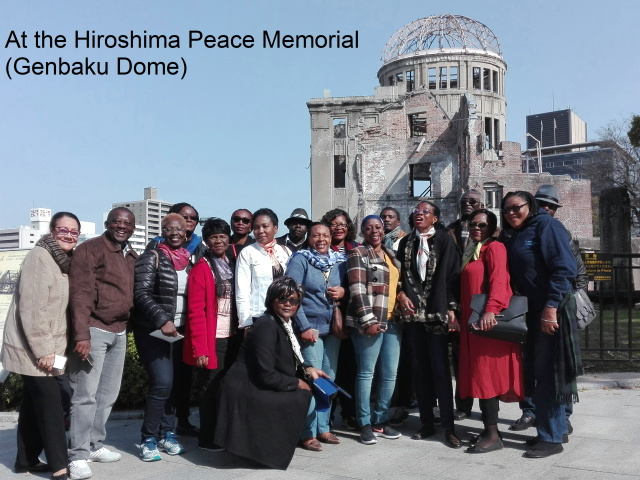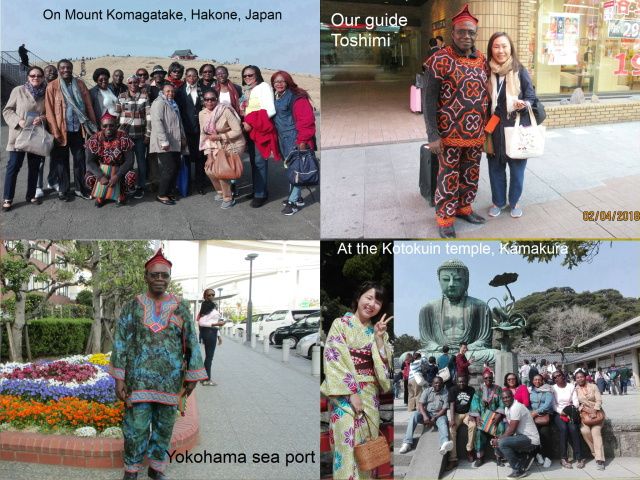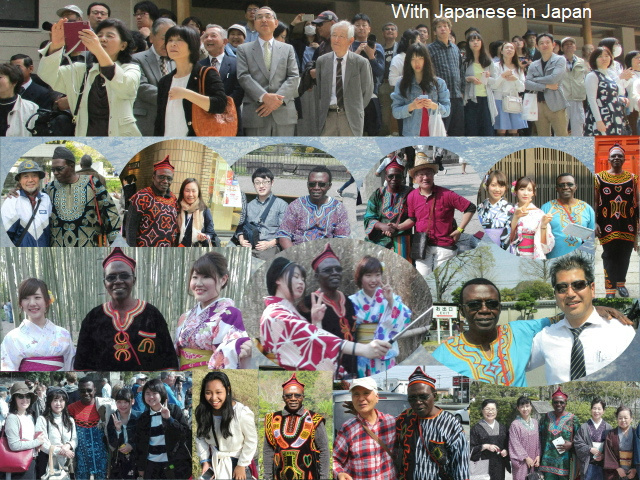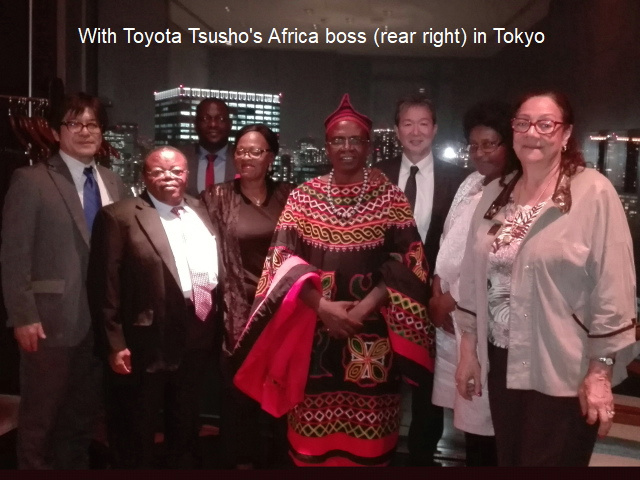18 Apr 2018
Visit to Japan
Our group of 22 mostly Cameroon based pharmacists left Paris for Osaka, Japan on the 26th of March on our first leg of a ten days visit to ‘the land from where the sun rises’.

Japan (pop. 127million) is a highly developed country consisting of 6852 Islands with a surface area of 377944sqkms. It is one of the most densely populated countries in the world with 93% of its population residing in urban areas. Population density is about 349 persons per square km compared to Cameroon’s 50. Life expectancy at birth in Japan is 83.7years (one of the highest in the world) and this is striking when you consider the fact that life expectancy at birth in a number of African countries is below 50 years.

Japan sits on a tectonic plate and earthquakes are a fact of life in this country. It is estimated that about 1500 earthquakes occur there annually (majority which are minor quakes detectable only by seismographs). The country has some of the most stringent building codes anywhere in the world. That is why even 40 to 50 story buildings can withstand violent earthquakes that will in other parts of the world transform entire cities into rubble.

Japanese is the language spoken in this country followed to a limited extent by English. Again this is a huge country with one language compared to some African countries with more than 200. Buddhism and Shintoism (40 & 4% adherents respectively) are the major religious faiths of the Japanese. Christians make up slightly over 2%. During our visit, we had the opportunity to visit a varying range of Buddhist temples and Shinto Shrines in such cities and towns like Nara, Kyoto, Hiroshima, Ise, Nagoya, Kamakura and Tokyo. The settings of these temples and Shrines are extremely beautiful and uniquely natural in outlook. In Shinto religious beliefs, kami (spirit) is present in all of nature be it trees or rocks or mountains and also in man. The shrines are all constructed in a way to maintain a link between kami, man and nature.

In all, we covered a total of about 1300 kms visiting the above named cities plus Osaka, Hakone and Odawara all situated within the highly populated southern half of Japan. Japan attracted 28.69 million tourists in 2017. The visit to Hiroshima was quite memorable as this is the city on which the first atomic bomb was dropped in 1945. A visit to the peace museum here will bring you face to face with the reality of what transpired in this city when the bomb wiped out about 90% of its population.

The Japanese, Koreans and Chinese physically look the alike. I asked three different Japanese how one could physically differentiate between them and citizens of Korea and China? All admitted it was not easy to do so. Two things stand out clear to anybody visiting Japan for the first time...the cleanliness of their environment and the respectful way the Japanese greet people. Their streets, parks and hotels are very clean. Generally, Japanese do not enter the house with shoes used outside of the house. On about four occasions during our visit we had to remove shoes before entering a typical Japanese restaurant. The rule is relaxed for hotels due to the varied origins of their clientele. The Japanese usually greet people with a respectable and reverence bow that conveys a message of humility from them.

Japanese do celebrate the colourful blossoming of cherry flowers that occur once a year and last less than two weeks. We were lucky to be visiting during the period of cherry blossom.
Japanese look slim and physically fit. I remember joking to a Japanese corporate executive that it seems the only obese Japanese are sumo wrestlers. An overwhelming number of Japanese usually dress up in Western style clothes. You are most likely to see people in traditional kimono attire at touristic sites.
The cuisine in Japan is strikingly different from what we are used to in our part of the world. If you want to know everything before you eat, you will soon get confused. My approach while there was to eat as many unknown stuff as possible, and I found most dishes delicious

Meeting with Toyota Tsusho executive
Though financed by us individually, Laborex Cameroun played a pivotal role in the logistical and other organizational aspects of our trip to Japan. Laborex Cameroun is one of the leading pharmaceutical wholesale companies and those of us in community pharmacy practice are customers to Laborex. Prior to December 2012, the French distribution company CFAO had controlling shares of Laborex Cameroun through its health subsidiary Eurapharma. When Toyota Tsusho Corporation bought CFAO in December 2012, Laborex Cameroun became the defacto property of Toyota Tsusho Corporation. During our visit to Japan, the commercial director of Laborex Cameroun who was with us had a scheduled meeting with Kenji Suzuki, the senior General Manager, Africa Division of Toyota Tsusho Corporation.Toyota Tsusho is the marketing arm of Toyota Corporation. The Toyota executive was kind enough to extend an invitation to an additional five members of our group to share in the meeting and subsequent dinner. Mai de May, Laborex Cameroun’s commercial director made a brief presentation of the company whose annual turnover is about 50 billion XAF (approx 94 million USD).
Kenji Suzuki also made a brief presentation of Toyota Tsusho...a company which has over 1000 subsidiaries and affiliates globally. Toyota Tsusho (Africa Division) is present in 53 African countries except Libya which is in chaos. When we hear of Toyota, we only think about cars. In order to remotely appreciate how gigantic and complex Toyota Corporation is, I will refer you to these two websites (Toyota Tsusho and Toyota Corp). http://www.toyota-tsusho.com/english/ and http://www.toyota-global.com/

We rounded our trip in Tokyo by visiting the gardens of the imposing imperial complex (residence of the king) and also visited the Tokyo Metropolitan government building. We climbed to the 45th floor of this building to have a panoramic view of the city.
During our return trip on the 5th of April, we took a direct flight from Tokyo to Paris. It took us 12 hours 5minutes to cover the 10,050 kms. After waiting in transit in Paris for 5 hours, I took another flight which took 6 hours 10 minutes to cover the 5213 kms to Douala. In all, 18 hours 15 minutes is my longest duration airborne within a day of 24 hours.
Trip related videos
Parade of Sumo Wrestlers
https://www.youtube.com/watch?v=GT2HfS19EV4
View of Tokyo from the 45th floor of the Metropolitan government building
https://www.youtube.com/watch?v=j4DbIBBzEuI
Grand Shrine complex Ise
https://www.youtube.com/watch?v=S83bv8TOrVU
Bullet Train
https://www.youtube.com/watch?v=DT_JOrhvOaw
Yokohama sea port
https://www.youtube.com/watch?v=m18QMJcS-Ew
Cherry blossom celebration in Hiroshima
https://www.youtube.com/watch?v=WqTrMCK6hmE
Hiroshima Atomic bomb memorial
https://www.youtube.com/watch?v=9hXNLA0UghA
Tokyo skyline
Njei Moses Timah
|